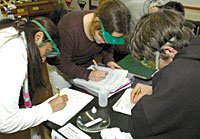No Books, No Problem: Teaching Without a Text
Thanks to a forward-thinking teacher, chemistry students quickly learn to love leaving the textbook behind.

The students in my general chemistry class almost never open their textbook. My reason: The less I use the book, the more they learn.
While some textbooks are excellent, most bore my students and frustrate me. "Readability formulae" produce mind-numbing prose. Since textbooks are marketed nationally, they must comply with content standards for all states, resulting in ten-pound tomes that cover all topics superficially. Many promulgate scientific misconceptions or even outright errors. (For more on the trouble with textbooks, see "A Textbook Example of What's Wrong with Education".) They present ideas didactically as discrete facts to be accepted, rather than as clues of principles to be discovered and explored.
Some textbooks do a fabulous job of making science relevant, but others insult students' intelligence by oversimplifying and fragmenting the subject matter so much that it becomes incomprehensible. Still others explore only a few topics instead of a standard content set.
I didn't set out to banish the book from my classroom. During my first year of teaching general chemistry, I based much of my curriculum on the textbook. In my second year, I gave each student a textbook yet assigned very little from it. Finally, in my third year, I scrapped it altogether and haven't used it since. I realized the textbook's deficiencies and substituted alternate curriculum for topics that my students needed help in mastering. As I added more extra resources, I found that students learned far more when I didn't assign the book.

Without a textbook, I can create curriculum that engages students by relating science to their everyday lives. Lessons become clearer when I link the topic to an issue that affects them personally. For example, many of my students live in poor, heavily polluted areas, so when we study intermolecular properties and precipitation reactions, we examine the air and water quality in their neighborhoods. Students learning about precipitation explore how two toxic substances can dissolve in the nearby bay and then combine to form a solid that accumulates at the bottom. When we're studying electrochemistry, I assign projects in which students design cell phone batteries that are cheap, environmentally benign, and of the appropriate voltage.
Teaching without a textbook means more prep time, especially in the first few years. It means amassing and adapting curriculum from a wide variety of sources, including journals, lab books, Web sites, packaged curricula, and other teachers. It means mapping this collection to the standards of your school and state. In addition, it means proactively engaging and persuading the administration, the teaching staff, and the parents that ditching the textbook is in the students' best interests. But it's worth this effort. My students are more engaged, they understand more and act out less, and they develop a deeper comprehension of the subject matter.
But the process was a gradual weaning. I wouldn't recommend that any teacher -- particularly a new teacher with multiple classes to prepare for -- try to create a year's curriculum alone or over a single summer. Beginners should take careful note of which lessons are working and why, and then make adjustments suited to their students. (For more information, see "How To: Toss the Text".)
For example, students at my high school typically have stronger reading and writing skills than math skills, so I integrate a review of basic algebra concepts throughout the year. At the beginning of the school year, I take several days to make sure my students can manipulate variables in simple formulas. It's a skill that recurs throughout any chemistry class but is not covered in chemistry textbooks.
Credit: Francis DaSilvaIn addition, my students learn particularly well when they work together to discover scientific ideas and apply them to new situations. For instance, I have them organize their own versions of the periodic table from a subset of information and then work out the principles underlying the periodic table as accepted today.
Whenever possible, I use curriculum that encourages students to draw their own conclusions. For instance, my students come to understand the logic behind the periodic table by sorting cards containing information about a particular element. Through this activity, students come to understand the reason for the curious shape of the table -- an arrangement that even some chemistry majors cannot explain coherently.
The lesson plans scripted by textbooks rarely leave room to deviate from standardized curriculum, but such detours are essential to confront and correct students' misunderstandings. My lesson plans include activities to make sure students distinguish the nucleus of an atom from the nucleus of a cell -- I don't want to hear my chemistry students define the nucleus as "the brain of an atom." When we cover the sizes of atomic particles, I build in a review of negative exponents and powers of ten so that no student believes that electrons, at about 10-27 grams, are bigger than protons, at about 10-24 grams.
My curriculum is also peppered with activities that allow me to gauge the students' understanding and adapt quickly to their needs; such unscripted activities are anathema to many textbook publishers. We play a modified version of bingo, called chemgo, that uses cards covered with atomic symbols or other chemistry terms to reinforce concepts like the organization of the periodic table. Students cross off symbols that correspond to statements like "the noble gas with the heaviest atoms." In this game, I work from a list of skills that I want students to master; as students play, I pick topics that give them the practice they need. Even while teaching complicated concepts in a difficult subject, I tailor curriculum to my students, not the other way around.
Though I don't discuss with the students my rationale for shunning a textbook, on a recent student feedback form, I asked them whether they'd prefer to use one. More than 95 percent said no. Some complained that textbooks are heavy; many derided them as boring or difficult to read. As one student put it, "Textbooks are filled with stupid words that make things harder." Several responses indicated that textbooks are useful only for certain kinds of learning. "You don't learn stuff from textbooks," one student wrote. "You just memorize for a test, then forget it." I won't settle for that in my classroom; without a textbook, I don't have to.
Geoff Ruth teaches chemistry and biology at Leadership High School in San Francisco. Write to gruth@leadershiphigh.org.
How To: Resources
Access Excellence This site explores topics ranging from DNA research to sleep disorders for the benefit of health and bioscience teachers and students.
Chem Matters (part of Chemistry.org)Chem Matters is a monthly publication that produces engaging articles about chemistry, making it accessible to high school teachers and students.
The Sourcebook for Teaching ScienceThis site provides a compendium of Web activities for all areas of science.
The Exploratorium Teacher Institute The Exploratorium offers easy hands-on activities for high school science.
HistoryTeacher.Net A compendium of Internet links, ranging from media sites and the Library of Congress to historical societies and legislative sites.
The Khan Academy A video library of math and science lessons.
Go to "How To: Toss the Text."